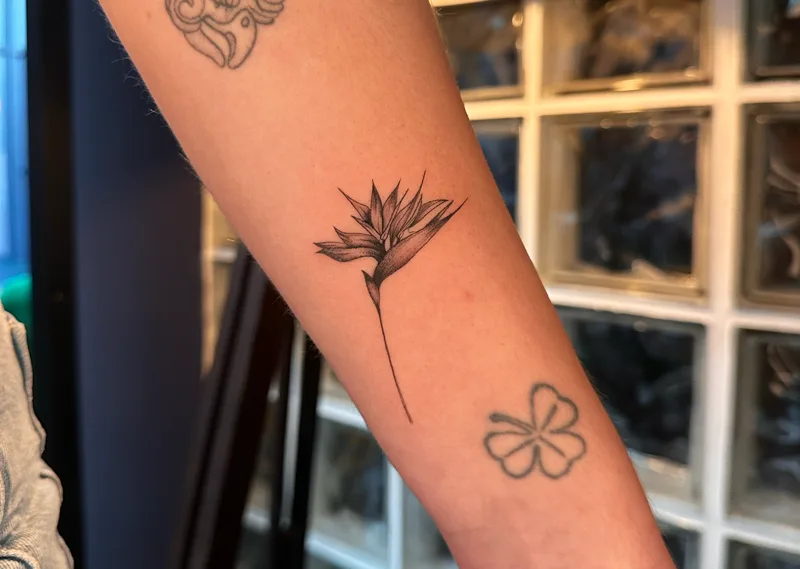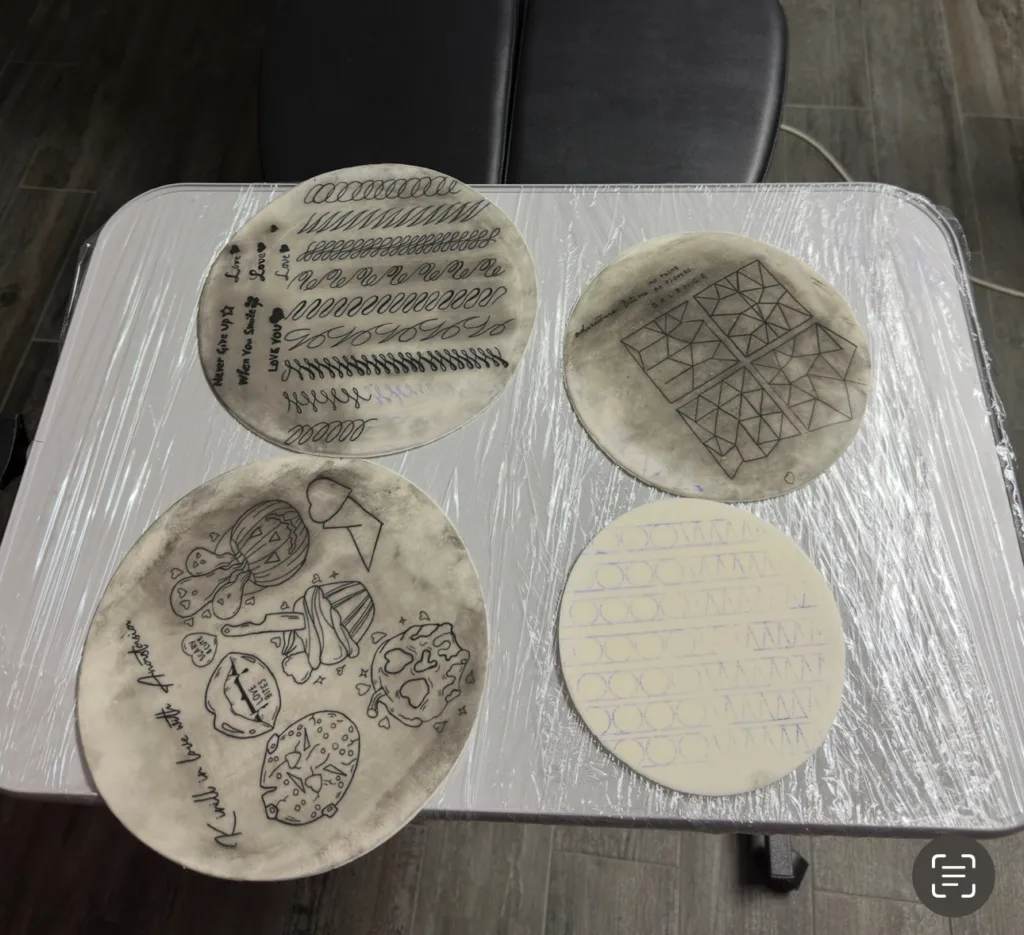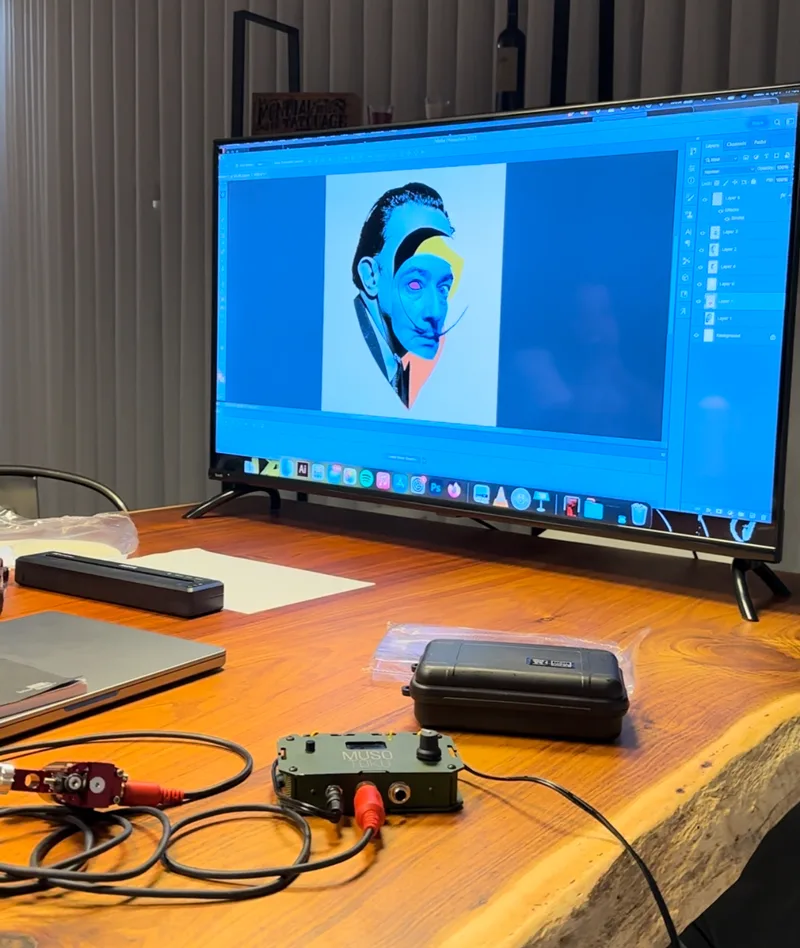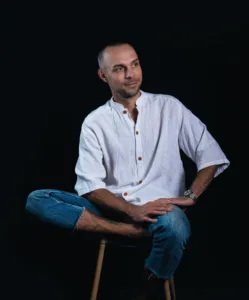How to Become a Fineline Tattoo Artist
Hello. My name is Kirill Goldbek. I am a professional tattoo artist. My studio is located in Funchal, Madeira Island, Portugal. I have lived on the island since 2022. My acquaintance with tattoos took place when I was 17 years old. My father began his career as a tattoo artist back in 2006. He studied with a famous master, and it so happened that I was always present with my dad during the training. I attended all possible tattoo master classes, workshops, and tattoo conventions. At that time, it was difficult to find professional-grade tattoo machines that you can see on sale now. Then all tattoo machines were made by hand, these were custom coil machines. Below you can see a photo of my first tattoo machine, which my father made and then gave to me.

With this machine, my path as a budding tattoo artist began.Imagine the tiny hand of a 17 year old holding this monster. Can you imagine it? Now let’s add strong vibration from the coils, long cords going into the pedal that stands on the floor, and classic tattoo needles. At that time, there was no talk of compact professional tattoo cartridges for the machine. Everything was harsh.

My first tattoo projects were done for my friends, then I looked for my parents’ friends who were older and agreed to trust me with their skin. Below, I will publish some photos of the works I managed to save. The works are large, featuring thick traditional lines, abundant black ink, and solid black saturation. It was difficult to work differently then. My hand shook for several hours after each tattoo session from the vibration of the machine.


Since 2006, I have visited many tattoo conventions, met tattoo artists, and worked with clients. It was my hobby, I never devoted much time to it. I was young, and I was investigating how to realize myself in other areas of life and business, so tattooing was always in the background, as a hobby, but it was always with me.
In 2022, upon relocating to Madeira, my hobby evolved into a comprehensible tattoo business and a manifestation of my creativity. You can see my work, development, and progress in my Instagram profile. I would be glad for a subscription to my profile and likes on my portfolio.
So, let’s talk about Fineline Tattoo. What is it? What tattoo artists can do such work? Which of the clients like fineline tattoos?
Understanding Fineline Tattooing and What is Fineline Tattoo?
Many of my clients often ask the same question: what is a fineline tattoo and what are the differences between a fineline and a traditional tattoo? The tattoo industry has been developing quite quickly in the last few years, and many clients still think that tattoos can only be like they were 15–20 years ago. But no, the world is moving on, and so is tattoo art and the skills of tattoo artists.
Fineline tattooing is a complex art form that emphasizes precision, detail, and minimalism. Unlike traditional tattoos, which rely on thick and thin lines, color fills, shading, etc., fineline tattoos use thin, delicate lines to create elegant and sophisticated designs. This style often incorporates intricate patterns, geometric shapes, or realistic images, appealing to those looking for a more subtle and understated aesthetic. The technique requires exceptional skill and a steady hand, as even the slightest mistake can throw off the balance of the design. Fineline tattoos are especially popular due to their versatility, allowing you to create both small, understated pieces and larger, more detailed compositions. With fineline tattoo techniques, you can create stunning microrealism tattoos. Fineline tattoos represent a modern approach to tattooing, combining craftsmanship with sophistication.

Tattoo Education and Training Requirements
Tattoo education and training are essential for new tattoo artists to master the craft and to ensure safety and professionalism. While formal education is not always required, many artists will apprentice under experienced tattoo artists to learn techniques, hygiene, and client interactions. Training typically includes learning equipment handling, skin anatomy, sterilization protocols, and artistic skills such as drawing and shading. Especially if you are looking to get a specific education for fineline tattooing, you will need to work hard to find the right tattoo artist for you who can introduce you to a niche tattoo style and provide you with exceptional skills in this narrow area of tattoo specialization.
You should also be aware that some countries and regions require certification or licensing for tattoo practice, which may include passing health and safety exams, as well as completing bloodborne pathogens training for tattoo artists and receiving a certificate upon completion of the course. This type of training is a common practice for tattoo artists in the United States and Canada. Continuous learning and upgrading your skills and abilities is crucial, as artists must stay current with trends, tools, and regulations. A solid foundation in both art and technical knowledge is key to building a successful and reputable tattoo career.

Tattoo Artist Education and Training Requirements
If you are interested in tattoo courses or tattoo education for fineline tattooing, you may have a question. What are the educational requirements for tattoo artists?
I will tell you as it is: there are no special requirements to become a tattoo artist. No matter what you are told and what information you read on the Internet, The main requirement is your desire and passion for tattoo art. Passion can become your profession or hobby, which will complement and fill your life.
Specific Education for Fineline Tattooing
Let’s talk about tattoo training and touch a little on the topic of fineline tattoo courses. On the Internet, you can find hundreds of online tattoo courses and thousands of articles about how to hold the machine in your hands, what types of needles exist, what inks are needed, how to use transfer gel, how to make tattoo transfers, etc. However, the reality is that no one can provide you with a formula for happiness, a blueprint for establishing a prosperous career as a tattoo artist, or a steady stream of clients.
Most online tattoo courses will promise you “mountains of gold” and tattoo certificates. Believe me, no one needs your certificate of completion of a tattoo course. You can hang it on your wall in your room, perhaps it will please you. This certificate will not enhance your skills in skin work, color filling, smooth shading, etc., but it will provide you with 100 video clips and PDF files that you can purchase along with the lesson.
If you want to become a specialist in a narrow direction of tattoo art, you need to look for specialized fineline tattoo and tiny tattoo courses. Yes, this can be online training, tattoo training in Zoom, or fineline tattoo courses that you will find in your city near you. If you find a tattoo artist who offers to teach you, be prepared to travel for their tattoo training class.
Essential Skills and Techniques
The essential skills and techniques for tattoo artists include precision, creativity, and a profound understanding of skin anatomy. Even if you possess exceptional professional knowledge of skin anatomy, the reality of working with live skin changes significantly. Understanding the structure of skin is just the beginning. Mastering linework, shading, and color blending is critical to creating cool tattoos. It’s a good idea to understand the different types of tattoo guns, their technical specifications, and which tattoo guns to use for a particular type of tattoo. Tattoo artists must also hone their hand-eye coordination when performing certain tattooing techniques. Knowledge of sterilization, hygiene, and safety protocols ensures a safe environment for clients. Effective communication and customer service skills help artists understand clients’ visions and build trust. Constant practice and the ability to adapt to new trends and tools are critical to growth and success in the ever-evolving tattoo industry. Understanding how social networks operate, how to shoot reels, how to photograph your tattoo work, how to manage your profiles, and how to build communication with clients will also be useful.

Artistic Abilities
Let’s talk about artistic talent. Do you need to be an artist or be able to draw on paper or canvas to become a tattoo artist? My answer is no. When I started to master the tattoo industry at the age of 17, I also carefully drew with a pencil on paper. I drew animals, birds, spherical objects, and shadow overlays and practiced drawing portraits. But, unfortunately, drawing skills emerged and helped me. Paper with a pencil and human skin are two different universes. Depending on the style of tattoos you want to create, you will need certain skills, but not necessarily artistic drawing skills.
Precision and Attention to Detail
I would highlight this point as the main one. Accuracy, attention to detail, perseverance, and concentration are some of the most important criteria that a beginner and professional tattoo artist should have.
When you make a tattoo for a client and do not use synthetic skin for practice, remember that the result is almost impossible to change. Every line, circle, shadow, and detail of the tattoo that you make for the client must be verified, precise, and without a doubt made exactly as it was on the preliminary design that you approved with the client. Any errors on the skin will be your responsibility. Both beginners and experienced artists often neglect their responsibility and create tattoos carelessly. Then, after a few weeks or months, the client looks for laser tattoo removal treatments to remove a tattoo from the skin that does not suit him or is done unsatisfactorily. Your goal is to make each job better than the previous one, always improve and be better than you were yesterday.
Understanding Skin Types and Ink Behavior
Understanding skin types and how ink behaves is essential for tattoo artists to achieve optimal results. Different skin types—such as oily, dry, or sensitive—affect how ink is absorbed and retained, influencing the appearance and longevity of a tattoo. Artists must adapt techniques to accommodate changes in skin texture, elasticity, and thickness. Additionally, understanding how ink interacts with skin helps prevent issues such as fading or discoloration. This knowledge ensures accuracy, improves tattoo quality, and minimizes risks, making it essential to creating long-lasting, vibrant designs tailored to each client’s unique skin characteristics. Often, even this knowledge is not enough each client, each new skin, is a new case. Dry skin on yesterday’s client and the client who came to you today do not provide you any information. These clients differ in terms of their skin types, tattoo designs, and tattoo locations, which presents a significant challenge for tattoo artists. Many tattoo artists do not adapt their equipment, machine settings, types of needles, ink, hygiene products, and tattoo care products to each client. You know, they use one type of needle for all types of tattoos and one ink for different skin types. At the end, they smear it with Vaseline, wrap the tattoo with cling film from the kitchen, and send the client home. To be honest, you can always do better for the client, always. If you have the desire and passion to make high-quality art and collect only positive reviews and gratitude from clients, please develop and improve your methods and techniques of tattooing.
Tattoo equipment
Now I will answer frequently asked questions and even misconceptions that beginner tattoo artists have.
Fineline Tattoo Machine
There is no such machine. Every tattoo machine can be used for the fineline tattooing process. Beginners try to find a specific brand or tattoo machine that will do all the work for them. Miracles do not happen, especially in the tattoo industry.
Types of Fineline Tattoo Machines
It would be more correct to talk about the types of tattoo machines. These are coil tattoo machines and rotary tattoo machines. We can divide each type of machine into several subcategories, but it is not crucial. If you are looking for a fineline tattoo machine, then my recommendation is to look at tattoo machines with a stroke of 4.0 or more. What is a stroke in a tattoo machine, you ask? In tattooing, a stroke refers to the distance the needle bar of a tattoo machine travels up and down during operation. It is measured in millimeters (mm) and determines how deeply the needle penetrates the skin.
I once did a tattoo for a client. It was a thick, bold line running across the entire body, starting from the wrist, then going across the neck, back, buttocks, and down to the feet. I used a fairly powerful machine with a needle stroke of 4.0 mm and a professional 9 round liner needle from Cheyenne, and by the end of the tattoo session, I realized that I needed a machine with a needle stroke of 5.0 mm. This would allow me to make a perfect line, especially on the buttocks, where the skin is more challenging to tattoo. Now I have a tattoo machine that allows me to make perfect lines.
Fineline Tattoo Pen vs. Fineline Tattoo Gun
Tattoo artists and tattoo supply stores call tattoo and permanent makeup machines differently. On the Internet, you can find the same machine with different designations: tattoo pen or tattoo gun. Permanent makeup applications often utilize pen machines. Permanent makeup artists refer to their machines as “pens” because they are often very thin and light, like a ballpoint pen. Do not be misled by different names for the same machine. You should pay attention to such indicators as power, voltage, current, proven tattoo machine brands, and testing the tattoo machine live, in your hand, on synthetic skin, and on the skin of clients. Each tattoo artist has his favorite tattoo machine.
Choosing the Right Needles and Inks
For any type of tattoo, it is important to understand which needles are best for a particular area of the tattoo. For tattoo lines, artists often use 3RL, 5RL, 7RL, 9RL. It all depends on the style and design. The thickness of the needle can also vary, as can its sharpening. Different areas of the body will react differently to the same needle. Therefore, tattoo artists should always have several types of needles at hand.
The choice of ink for a tattoo is also a very personal topic for each tattoo artist. For color tattoos, I use ink from the Intenze brand. I also have a color palette from World Famous Ink. I have black ink from several brands: Dynamic, Intenze, Panthera, World Famous, and Kuro Sumi. I prefer to have a large number of ink variations so that I can quickly select the right brand and type of ink for any design or skin type.
The choice of needles, like ink for a tattoo, is a very personal story. There is no universal recipe. Many tattoo artists use certain brands of needles and inks for many years without changing anything. Such practice allows them to achieve gorgeous, stable results in their work. When you have a proven brand of ink that does not change its composition and palette for many years and when you have several types of needles from top brands, then you have the opportunity to focus your efforts and attention on the quality of shadows, lines, and other nuances that will make the tattoo even better for the client.

Building Your Portfolio
Creating your portfolio is a long and continuous process. A tattoo portfolio is your business card. Clients choose tattoo artists primarily based on their work and style. During the first months and years, beginning tattoo artists work only to build their portfolio. To speed up the creation of a quality portfolio, you will need to constantly strengthen your skills and perfect your abilities. Attending workshops and personal tattoo training will help you achieve the best results in the shortest possible time. Documenting your work is an important stage of your career, which you need to pay special attention to and choose the appropriate channel of communication with your future clients. This can be Instagram, YouTube, TikTok, a website, Reddit, Threads, Twitter, etc.

Creating Fineline Designs
Clients often ask if they should look at your designs or a catalog to find a suitable tattoo. In addition to the portfolio that you will create, you will definitely need skills and knowledge to work with graphic editors. Such programs exist for iPad, Mac OS, Windows, and iOS. Basic knowledge of the functions of such programs is necessary to create an excellent catalog with beautiful fineline tattoo designs.

Practicing on Synthetic Skin
The first step in any tattoo artist’s career is working on artificial or synthetic skin. When I started tattooing, I couldn’t find synthetic skin for sale. Synthetic skin wasn’t available back then. I remember my dad going to the local market every weekend and ordering pigskin from the butchers. That was the beginning of my tattoo artist career. But now, you have a wonderful opportunity to buy synthetic skin instead of tattooing a pig. Synthetic skins come in different brands, thicknesses, densities, and sizes. It can take a lot of time and orders from different stores to find the right synthetic skin for your students. I only select the best materials for my work and training.


Gaining Experience
I remember in 2024 I got a record number of requests for apprenticeships. I had many new tattoo artists writing to me offering their services to help out in my tattoo studio on the island of Madeira in exchange for the opportunity to be in the tattoo studio and gradually learn tattooing and improve their skills. This is a good way to gain new skills, but the likelihood that you will be able to find a tattoo artist in your city who will have the opportunity and need to take an assistant is very small.
The next opportunity to gain more experience in tattooing is working in a tattoo studio. Tattoo studios often look for residents to fill vacant positions. But again, it is very difficult to find such a studio, and accordingly, your tattoo skills must already be at a fairly excellent level. Tattoo artists often work on a percentage of the tattoos they make. The studio is responsible for finding and attracting clients. Some tattoo artists rent space in the studio and pay rent and work only with their clients. This option is cost-effective, but only when you have your own clients. To have clients, you must have experience and a quality portfolio.
For advanced tattoo artists, the path lies through attending tattoo conventions and workshops. Every year from early spring to late fall, tattoo conventions are held around the world, which gather renowned tattoo artists and clients from all over the world. At tattoo conventions, you can even take part in a competition for first place in a certain tattoo category. If you have enough skills and passion to win an award, then look for information about such events, perhaps there is even a tattoo convention near you in your city.
Legal and Health Considerations
I have covered the legal and medical aspects of tattooing in both the US and the European Union. Licensing requirements vary widely. In the US, regulations vary by state, with some requiring mandatory training and internships in handling bloodborne pathogens, while others have minimal oversight. In the EU, countries like Germany and the UK require artists to obtain licenses, often including health and safety certifications, although standards can vary between member states.
Health and safety regulations are paramount. In the US, the FDA monitors the safety of inks, but enforcement varies. The EU’s REACH regulation provides stricter ink safety standards by banning hazardous substances. Both regions require studios to maintain a sterile environment, but the EU often imposes stricter inspections.
Insurance for tattoo artists is another important factor. In the US, liability insurance is required to protect against malpractice or infection claims. In the EU, insurance requirements are often linked to licensing, ensuring that artists are covered against health-related incidents.
Ultimately, while all regions, continents, and countries prioritize customer safety, centralized EU regulations often provide greater consistency. As an artist, I advocate for strict standards everywhere—our craft demands it. Whether in the US or the EU, awareness and compliance ensure that we can create art safely and responsibly.
Marketing Your Fineline Tattoo Services
Here we come to one of the revolutionary and fundamental factors of your success. Whether you have the necessary knowledge or skills to handle it yourself, or if you prefer to outsource to marketing and digital agencies, marketing a tattoo studio or building an online presence is a significant task. Regardless of which path you choose, it will require investment from you. Building your image on the Internet is a set of technical, creative, and graphic tasks. Imagine that you have completed online tattoo courses or attended private tattoo courses, and you have begun practicing on synthetic skin. However, the time has come when you must decide whether to continue or end your career as a tattoo artist, as no one is showing interest in you or recognizing your talent.
How can you effectively showcase your unique style to a wide audience on the Internet? Firstly, each tattoo artist is unique, with his own unique style and handwriting. This is your advantage. If you do not stop developing your skills, you will always be in demand. This is a path of several years, decades. Developing and building your image like fineline tattoo artist on the Internet will give you an excellent boost and bring recognition, perhaps even fame, in your city, country, and throughout the world.
Networking is a compelling word that tattoo artists often forget. Talk to people, tell everyone who you are, talk with other tattoo artists, describe in detail what you are doing and what fineline tattoo projects you do, invite people to your studio for coffee, attend events, and give people business cards. Leave a positive impression and try to make the next tattoo better than the one you did yesterday.
I trust the development of my tattoo studio to a digital marketing agency. Yes, it is expensive, yes, perhaps I could do it all myself, but then I will not create new tattoo designs and receive positive feedback from my clients. I give my students basic knowledge of digital marketing and building their brand on the Internet. Believe me, even this basic knowledge will be enough for you to get the first results in attracting clients for your fineline tattoo services.

Continuing Education
Building a career as a tattoo artist is probably not that difficult. The big challenge is to develop yourself and your skills and get better every day, every month, and every year. Keeping that spark and passion for tattooing that will be with you all your life is a very difficult process. Self-analysis, self-criticism. I am constantly working on my mistakes, striving for progress, and engaging in continuous tattoo training.
Tattoo trends change, and so do tattoo equipment manufacturers. How can one stay updated with tattoo trends? One way to stay updated with tattoo trends is through networking, as I discussed previously. Furthermore, traveling to other countries, years, and studios will give you an excellent boost in your career. The trip will allow you to get acquainted with new trends and look at different cultures, which are also reflected in tattoos.
Many tattoo artists work in a certain style that has not changed for years, and they are quite successful, famous people. Other tattoo artists are trying to find their style, and so far they do not have a specific style in which they work. I always recommend my students try themselves in different tattoo styles, get inspired by painting and modern art, watch cartoons, and play games.
In my studio on the island of Madeira, I organize advanced fineline tattoo classes. This training is intended for tattoo artists or permanent makeup artists who have already held a tattoo machine in their hands and understand the basic principles of the tattooing pSuch an approachss. I prefer to conduct individual tattoo trainings in my tattoo studio. This allows me to fully immerse myself in the training process and provide maximum information and practice to my students. We go through all the stages, from developing fineline tattoo designs to photographing the tattoo at the end of the session. I teach my students all the skills that will allow themimprove their subsequent workstter. After students finish the fineline tattoo class, we move on to studying basic marketing skills and digital marketing tools.
In my studio I also conduct a tattoo course for beginners. This training lasts up to 1 week. In all my training programs, I include a wealth of practical and relevant information. I always update and supplement tattoo education courses with new materials, especially digital marketing tools, which I first test in my studio. If these tools work and bring results, I include them in the training program update.
Let’s imagine that you want to take training with me, but you are in another country or you do not have the opportunity to visit my studio for several days in a row. I provide various formats of tattoo courses and trainings for professionals and beginners, online fineline tattoo courses are one such format. I have the opportunity to conduct live broadcasts with my students. You will be present in my studio and watch all stages of training and practice with me online. I would like to help you improve your tattooing skills by focusing on hand techniques. I can do this only if you take tattoo training in my studio.
In any case, I will do everything possible to make your fineline tattoos better, your portfolio grow, and the number of clients in your studio increase more and more every month.

Conclusion: Embarking on Your Fineline Tattoo Artist Journey
If you are still reading this article and still aspire to become a tattoo artist or enhance your tattoo skills, then you are on the right path.
In this article, I described the major stages of a tattoo artist’s life and career. Believe me, there is even more information in real life. The real skills and knowledge that you need to have are much more extensive. In this article, I did not touch on the stages of work and communication with clients; this is a separate large block that I discuss with my students.
A professional tattoo artist is not just somebody who bought a tattoo kit on Amazon, bought a Chinese box of needles, and created an Instagram in which they wrote that they are a tattoo artist.
A tattoo artist is a combination of many professional, creative, and human factors. Moving into a more professional tattoo sphere requires significant investment and responsibility. Therefore, tattoo artists are not born but become.
Are you ready to constantly learn, improve your skills, and make tattoos every day better than yesterday? Are you ready to invest and know how to take responsibility? Then welcome to tattoo fam.
With Best Regards
Kirill Goldbek


